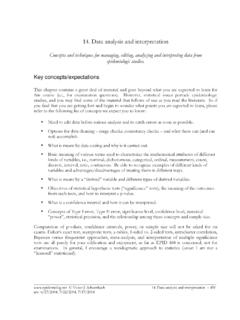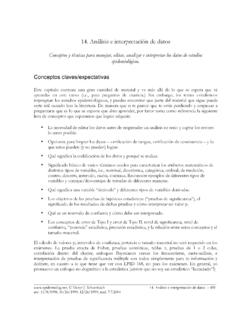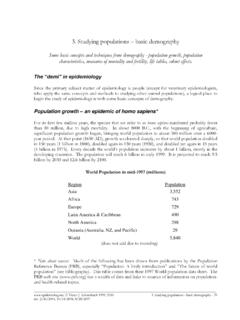Transcription of Standardization of rates and ratios - epidemiolog.net
1 6. Standardization of rates and ratios * Concepts and basic methods for deriving measures that are comparable across populations that differ in age and other demographic variables. Overview Epidemiologists are always mindful of population diversity. Virtually every large population is heterogeneous in regard to sociodemographic ( , age, gender, education, religion), geographic, genetic, occupational, dietary, medical history, and innumerable other personal attributes and environmental factors related to health. A population can be viewed as a composite of diverse subgroups (ultimately, subgroups of size one, , individuals, but epidemiologic measures break down at that point).
2 Any overall measure or statistic reflects the value of that measure for each of the subgroups comprising the population. An overall measure that does not take explicit account of the composition of the population is called crude. Its value will be an average of the values for the individual subgroups, weighted by their relative sizes. The larger the subgroup, the more influence it will have on the crude measure ( , "democracy"). Thus, the death rate for a population is a weighted average of the death rates for its component subgroups. Suppose we consider a population of size N as consisting of five age groups, or strata. Each age stratum will have a specific number of people, say ni (i=1 to 5).
3 During the following year, each stratum will experience some number of deaths, say di. The total population size, N, is therefore ni, the total number of deaths, D, is di, and the crude mortality rate is D/N, which can also be written as a weighted average of the stratum-specific mortality rates , di/ni, as follows: D di ni (di/ni) = = = (ni/N)(di/ni) = wi(di/ni) N N N where wi are the weights (note that wi = (ni/N) = ( ni)/N = ni/ ni = 1). The crude rate is the simplest and most straightforward summary of the population experience. But mortality is strongly related to age, so the stratum-specific mortality rates will differ greatly from one another.
4 The summary provided by the crude rate glosses over this heterogeneity of stratum-specific mortality rates . _____ * (An earlier version of the chapter was prepared by Timothy Wilcosky, ) _____ , Victor J. Schoenbach 1999 6. Standardization - 129 rev. 12/22/1999, 1/13/2000, 9/10/2000, 6/12/2003 This issue is particularly relevant when we compare rates across populations or time periods, because if the populations differ in composition, then at least some of what we observe may be attributable to these differences. For example, suppose you and a friend each agree to bring 10 pieces of fruit to a picnic. You stop at a fruit stand and buy 8 mangoes ($ apiece) and 2 apples ($ apiece).
5 Meanwhile your friend goes to the supermarket and buys 2 mangoes ($ apiece) and 8 apples ($ apiece). Which is the more expensive purchase? From one perspective, the first purchase is the more expensive, since $ is certainly greater than $ But from another perspective, the second purchase is more expensive, since the supermarket charged a much higher price for the mangoes and only slightly less for the apples. Which of these perspectives you choose depends on the purpose of your question. More often than not, the epidemiologist (and the serious shopper) would ask whether the prices were higher in the fruit stand or the store and by how much. We can answer that question by simply comparing the price lists.
6 But what if you also bought oranges, melons, grapes, and bananas? What if you bought two dozen varieties of fruit? It would certainly be more convenient to have a summary measure that permitted an overall comparison. The trouble with total cost ($ versus $ ) or average price ($ of fruit versus $ per piece) is that the fruit stand average price gives more weight to the price of mangoes, because you bought more mangoes, whereas the supermarket average price gives more weight to the price of apples because your friend bought more apples. We re comparing apples to mangoes, instead of fruit stand to supermarket. Clearly what we need is a procedure that averages the prices in the same way for each vendor, so that both averages give the same proportionate weighting to mangoes.
7 The average prices will depend upon the weighting we use, but at least we will be comparing (proportionally speaking) apples with apples and mangoes with mangoes. However, it s also clear that at least in this example, the weights will determine which seller is favored by the comparison. The fruit stand owner will prefer a higher weight for the price of mangoes, so that her prices will seem the better bargain. But the supermarket owner will prefer a very low weight on the mangoes. He might argue, in fact, that mangoes are a specialty item and not really worth considering in the comparison. He might argue for assigning zero weight to the mangoes, so that his average price will be (the summary is simply the price of the apples), which is less than the fruit stand charges for apples.
8 Which set of weights is the right one to use? People who don t like mangoes might agree with the supermarket owner. People who like mangoes or fruit stands would not. For the most part, the choice of weights ( the standard population) is based on convention, the intended and potential comparisons, and various other considerations. There is often no absolute correct choice, and there can easily be different opinions about the best one. But it helps to have a rationale for the choice other than that it happens to give you a result you like. Finally, nothing you do about weights is going to change the fact that your purchase did cost more than your friend s, so the crude summaries are not irrelevant.
9 Adjustment and Standardization The terms "adjustment" and " Standardization " both refer to procedures for facilitating the comparison of summary measures across groups. Such comparisons are often complicated by _____ , Victor J. Schoenbach 1999 6. Standardization - 130 rev. 12/22/1999, 1/13/2000, 9/10/2000, 6/12/2003 differences between the groups in factors that influence the measures of interest but which are not the focus of attention. Adjustment attempts to remove the effects of such "extraneous" factors that might prevent a "fair" comparison. "Adjustment", the more general term, encompasses both Standardization and other procedures for removing the effects of factors that distort or confound a comparison.
10 Standardization refers to methods of adjustment based on weighted averages in which the weights are chosen to provide an "appropriate" basis for the comparison ( , a "standard"), generally the number of persons in various strata of one of the populations in the comparison, an aggregate of these populations, or some external relevant population. Other kinds of adjustment, some of which also employ weighted averages, will be discussed in the chapter on Confounding. Most textbooks of epidemiology present the topic of rate Standardization in relation to adjusting for age. This tendency is not coincidental, since virtually all mortal or morbid events occur with different frequencies among groups of different ages.


















